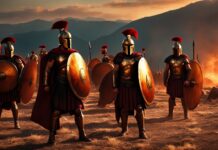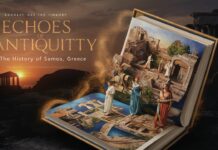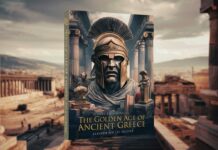Greek mythology is full of stories with gods, heroes, and magical creatures. One Greek island is only in myths, filled with ancient legends and stories. Let me take you to a world where gods walked the earth and amazing things happened.
In the Ionian Sea, Ithaca is a beautiful island with blue waters and rocky coasts. It was said to be the home of Odysseus, a hero from Homer’s Odyssey. Odysseus went on a long journey home, meeting mythical creatures and facing the gods.
Ithaca’s history goes back to 3000 BC, even before Odysseus’ time1. People lived there for thousands of years, through many civilizations. The island was ruled by different powers over time.
At its peak, Ithaca had 12,000 people, a lively community1. But by the 1500s, only 60 families lived there1. The island was ruled by the Normans and Franks in the 12th and 13th centuries1.
The Turkish Empire ruled Ithaca for 30 years starting in 14791. The islanders faced hard times but never gave up hope. When the Venetians offered land and tax breaks, people started coming back to Ithaca.
Today, Ithaca is thriving again, with a population of 12,0001. In 1864, it gained freedom during the War of Independence against Turkey, showing its strength and courage1. The Ithacans began to move around the world in the early 1900s, sharing their seafaring skills1.
But Ithaca faced challenges in the 20th century too. World War II brought German and Italian forces, forcing people to hide in the mountains1. Still, the islanders stayed strong, fighting to keep their traditions alive.
A big earthquake hit in 1953, destroying many buildings and making rebuilding hard1. But Ithaca came back stronger, its people united and ready for the future.
Today, Ithaca is a real island, but its mythical stories and people’s strength make it special. Its legends still inspire us, showing the power of myth and human spirit.
The Myth of the Minotaur and the Palace of King Minos
The Minotaur was a creature with a bull’s head and a man’s body. King Minos of Crete was ashamed of it. He asked Daedalus to build a maze at the Palace of Knossos for the Minotaur2.
The Palace of Knossos was a grand place in Crete. It was famous for its beautiful buildings and its role in history3. Daedalus made a maze that was so complex, no one could get out. The Minotaur lived there, eating those who got lost2.
Theseus, an Athenian hero, went into the maze to fight the Minotaur. He had a sword and help from Ariadne, the king’s daughter. Together, they beat the Minotaur and left the maze2.
The story of the Minotaur and King Minos is a big part of Greek myths. It has been told and retold in stories and art. Today, the term “minotaur” is used in fantasy stories to mean a creature with a bull’s head2.
Coins from the fifth century show the Minotaur and stars, linking it to the sky2.
The Palace of Knossos: A Glimpse into Minoan Civilization
The Palace of Knossos is on the island of Crete. It shows us the Minoan civilization, linked to King Minos. Some think King Minos was real, but most believe he’s a myth4.
Archaeologist Sir Arthur Evans named this civilization the “Minoan” after King Minos from myths4. Minos was said to be a strict ruler who sacrificed Athenians to the Minotaur4.
He got laws from the gods and was educated by Zeus. This made him a complex figure4.
King Minos had many children, including Ariadne and Theseus. The Minotaur was born from his wife’s affair with a bull. Daedalus built the maze for it4.
Theseus defeated the Minotaur with Ariadne’s help. This story shows Minos as an enemy and Theseus as a hero4.
The Minotaur and King Minos’ story is a great tale of gods, rulers, and humans4. It also tells us about the Minoan civilization and its impact on ancient Greece.
The Fall of Troy and Heinrich Schliemann’s Discoveries
The story of Troy’s fall is famous from Greek myths. It’s told in Homer’s Iliad and is a key part of ancient Greece’s history. The war started when Paris, a prince, took Helen, Menelaus’s wife. This led to ten years of fighting.
Heinrich Schliemann, a German businessman turned archaeologist, helped uncover Troy’s truth. In the 1870s, he dug at Troy in Turkey. His work changed archaeology and helped us understand ancient civilizations better.
Schliemann found important things that proved the Trojan War was real. He found ancient cities, layers of old cities, and valuable items. The site showed nine ancient cities and 46 layers of occupation over four thousand years. This shows Troy was lived in from the Early Bronze Age to its destruction by earthquakes in 1300 CE5.
Schliemann had 80 to 160 workers help him at Troy. Their hard work and Schliemann’s drive showed the city’s history5.
Schliemann dug a 14-meter trench through Troy’s ruins. He used pickaxes, shovels, and dynamite to uncover the city. His methods were new for archaeology then, but now seem old-fashioned5.
Schliemann found Priam’s Treasure, about 8,000 valuable items. He took it out of Turkey, causing a big controversy. The treasure showed how rich and beautiful ancient Troy was5.
Priam’s Treasure was found in an older layer of Troy. This made some question if it was really King Priam’s time. But Schliemann’s finds, including Priam’s Treasure, helped prove Troy existed and showed what might have inspired the myth5.
Schliemann spent over 20 years digging at Troy. His work helped future archaeologists. Wilhelm Dörpfeld, a German architect, joined him in 1881 and helped explore the site more5.
Thanks to Schliemann and others, Troy’s story is more than a myth. It’s a real part of history that still interests scholars and fans. It gives us a peek into the lives of people long ago.
Medusa and the Athenian Acropolis
Medusa is a famous mythological creature from Greek stories. She is known for her snake-like hair and deadly look. The myth says she was once a beautiful priestess of Athena but got turned into a monster6.
The Athenian Acropolis is a key place in the Medusa myth. It’s a hilltop in Athens with the famous Parthenon, a temple for Athena. Athena was key in Medusa’s story. The Acropolis shows Athena’s support and the deep myths of ancient Greece7.
Medusa’s story is deeply linked to the Acropolis’s history and design. In ancient Greek art, Medusa was a common theme. She was shown on temple decorations, vases, cups, and more7.
Over time, Medusa’s art changed. In old times, she looked scary with big teeth and a beard. But later, she was shown more like a human, still looking bold7.
Medusa also appeared in art from ancient to Renaissance times. A famous statue by Benvenuto Cellini shows Perseus with Medusa’s head. Perseus, who beat Medusa with help from Hermes and Athena, has inspired many artworks6.
Medusa’s image on the Acropolis shows how much people loved Greek myths. These stories deeply influenced ancient Greek culture and art7.
The Minoans and the Island of Lesbos
The Minoans were a civilization known for their advanced culture and skills at sea. They greatly influenced the Greek islands and the Aegean Sea. Lesbos is not directly linked to the Minoans but was important for the Greek language and culture. The Minoans, living on Crete, left a big mark with their buildings and art8.
The Minoans mainly lived on Crete but their beliefs might have inspired Minotaur stories. They loved bulls and practiced bull-leaping. These stories link to the ancient Minoans8.
Lesbos is famous for poets like Sappho and Alcaeus. It’s a key place in Greek language, literature, and culture. It had important centers for culture and learning, helping the Greek civilization grow9.
The Minoans and Lesbos are different but both have shaped Greek history. The Minoans helped with trade and cultural sharing in the Aegean. Lesbos helped with the Greek language and learning8.
The Legacy of the Minoans and Lesbos
Even though time has passed, the Minoans and Lesbos are still important in history. The Minoans influenced the Mycenaeans and left a lasting mark in the Aegean. Lesbos is known for its literature and thinkers, like Sappho, who are still celebrated today8.
The Historical Significance of Greek Mythology
Greek mythology has deeply influenced Western civilization’s religion, culture, and worldview. It has captured minds for centuries, offering deep insights into human nature and the divine. These myths, filled with gods and heroes, have entertained and shaped religious and philosophical beliefs.
The ancient Greeks believed in a world of gods and goddesses, each linked to life and nature10. Zeus ruled the skies and controlled the weather, while Hera watched over marriages and childbirth. Poseidon ruled the sea, and Aphrodite influenced love. Hades was in charge of the underworld, and Ares symbolized war’s chaos. These gods were not just perfect beings but relatable, with feelings and mistakes like humans10.
Today, Greek myths still echo in our culture. Stories like Pandora’s box and Theseus and the Minotaur are part of our shared knowledge. They’ve inspired art, literature, and film. Greek myths have influenced famous writers and artists, from Euripides to Rick Riordan.
Myths explained natural events and mysteries of life to the ancient Greeks10. They offered answers to questions about illness, death, and natural disasters. Greeks believed their gods controlled nature and influenced life. By pleasing these gods, they sought favor and protection. Greek myths helped make sense of the world and their place in it, offering order and meaning.
Mount Olympus, the gods’ home, is a key spot in Greek mythology11. It’s a place of divine power and epic stories. Greek myths also talk about Arcadia, Elysium, and the Underworld, each symbolizing spiritual and cultural beliefs11.
The Greek Creation Story and Comparative Mythology
Hesiod’s poems, “Theogony” and “Works and Days,” tell the Greek creation story around 650-750 BCE12. They describe the universe’s start and the gods’ origins. Chaos, Gaea, Tartarus, and Eros are key in shaping the world12.
Comparing Greek myths with others shows different views on creation. In Japan, the Kojiki tells of Izanagi and Izanami making Japan’s islands, starting with Onogoro12. Greek myths focus on earth and sky, while Japanese myths detail island creation. The Kojiki, written long after Hesiod, reflects Japan’s ancient religious traditions12.
There’s no proof of direct influence between Greek and Japanese myths. Yet, they share themes and show different cultures’ imaginations12.
Exploring Greek mythology and its comparisons gives us deep insights into culture and history. These stories help us understand our ancestors’ beliefs and values. Greek myths continue to inspire and captivate, offering endless ways to explore and create.
The Legacy of Greek Mythology
Greek mythology has deeply influenced Western culture. Its impact is seen in art, literature, and symbolism. From ancient pottery to modern art, Greek myths inspire artists. They create works that touch our feelings and make us think.
Greek myths have also shaped literature. They have inspired many authors over the years. These stories of heroes, love, and magic add depth to books across centuries.
Today, Greek mythology’s symbols are everywhere in culture. They appear in literature, poetry, and even daily talk. These symbols help share complex ideas and feelings across the world. They make us think about the world in new ways.
Greek mythology’s impact goes beyond art and literature. It has shaped ancient Greek society and culture. Myths guided people on what was right and wrong. They also linked to democracy, with leaders seen as gods’ representatives.
These myths brought people together, creating a strong sense of community. They were told at festivals, uniting people with their culture and history. Greek myths helped people feel connected to their past and future.
In conclusion, Greek mythology is still alive today. It touches many parts of Western culture, from art to society. Its stories and symbols continue to inspire and connect with us. Greek mythology is a key part of our shared heritage, offering deep insights into human nature13.
Conclusion
Greek mythology is a mix of history, religion, and imagination. It goes from Homer’s epic poems to the plays of Aeschylus, Sophocles, and Euripides. This has made a big impact on Western culture, arts, and literature.
Many places in Greek myths, like Troy and the Athenian Acropolis, have been found by archaeologists14. But one mythical island is only in myths15. It has caught our imagination, making Greek mythology richer.
Exploring Crete shows us the real side of Minoan civilization14. Some think Atlantis might have been a Minoan city16. Greek myths have a strong base in history and facts15.
Looking into Greek mythology, we find stories of mythical creatures and heroic quests. The tales of ancient Greece still excite us. They show the lasting power of stories. Greek myths prove our creativity and imagination are boundless.
Source Links
- History and Myth of Ithaca Greece. Ithaki Odysseas Mythology. Historic Ionian Island in Greece
- Minotaur
- MYTHS OF THE LABYRINTH
- Minos
- Discovery of Troy
- Perseus | Story & Facts
- Medusa in Ancient Greek Art | Essay | The Metropolitan Museum of Art | Heilbrunn Timeline of Art History
- History of the Cyclades
- Mycenaean Greece
- Everyday Life, Beliefs and Myths • MyLearning
- List of mythological places
- Are the creation stories of ancient Japan and ancient Greece more similar than we expect?
- Greek Society and Mythology | Kinnu
- 4 of Greek Mythology’s Real-World Locations
- Greek mythology
- Santorini & the myth of Lost Atlantis | Greeka

















